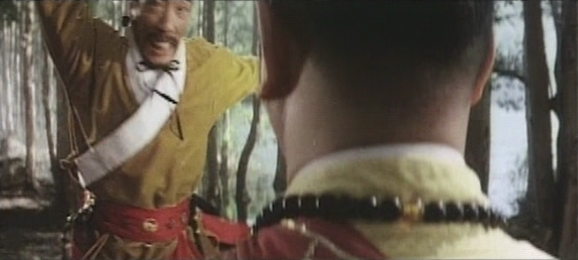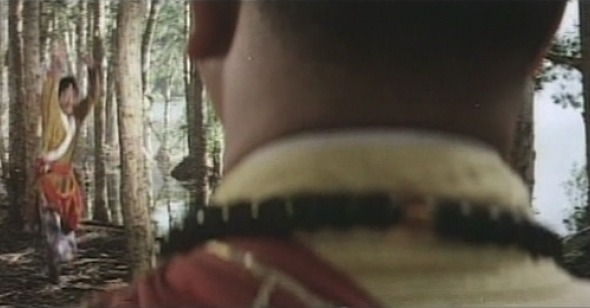Blow by Blow
Kevin B. Lee on A Touch of Zen
I do not consider myself an expert on wuxia pian, better known as the martial arts film, but I have seen enough to entertain the notion that just as there are competing schools of martial arts styles, there is a stunning variety of approaches to martial arts filmmaking. Moreover, as each school of martial arts exhibits an underlying philosophy, not just of combat or of movement but of life itself, the same can be said of certain martial arts films. Notwithstanding the majority of wuxia pian that have a largely demonstrative approach to their action scenes (the exhaustingly entertaining Invincible Armour (1977), which plays like a two-hour kung fu exhibition on crack, comes to mind), other films manage to do more than offer pyrotechnic chop-socky; they posit a distinct sense of meaning or emotion behind each punch and kick. Perhaps the quintessential example of the philosophical martial arts film is A Touch of Zen (Hsia Nu), by the legendary King Hu.
It is universally agreed that with his 1960s films Come Drink with Me and Dragon Gate Inn, King Hu was the first director to elevate the martial arts genre to a level of artistry. Hu's innovations lay in a heightened sense of atmosphere and a deliberate delaying of action scenes to divert the audience from seeking gratification in combat to enter a more contemplative mode of viewing. At three-and-a-half hours, A Touch of Zen was the most ambitious film of Hu's career, winning a special technical prize at the Cannes Film Festival but faring poorly upon its commercial release. It remains Hu's artistic pinnacle, his lasting attempt to enact the phenomenology of Zen Buddhism in cinematic terms while reinventing the martial arts film in the process.
A Touch of Zen's unique qualities begin with the epic, three-part narrative that charts a multicharacter journey from fearful superstition to Zen consciousness. Each section leaps ahead of its predecessor in cognition, like a kung-fu version of 2001: A Space Odyssey, beginning in the eerie darkness of night and ending with the screen literally bleeding with golden transcendence. In between, Hu investigates the process by which mankind comes into awareness of its existence. At the same time, he distills the martial arts genre to its own essence of moments, gestures, and sensations. It’s in this aesthetic inquiry that his editing plays a critical role.
There are too many great cuts throughout A Touch of Zen to mention, and many of them play in quick succession during Hu's fight scenes: a flurry of disjunctive cuts where trees, swords and wisps of human bodies alternate in split second shots, the bare minimum of time for them to register to the human eye. Ang Lee claims that A Touch of Zen inspired Crouching Tiger, Hidden Dragon (most notably in the bamboo forest duel, which recalls a bamboo forest fight in Hu's film for its setting and little else), but his sweeping, wide-angle long takes are the antithesis of Hu's furiously edited fights. This is not to say that Hu is the progenitor of today's noisy, overly edited action films that substitute a cacophony of noise and indistinguishable flashes for coherent staging (the same contemporary malaise in action filmmaking that Ang Lee sought to redress). Hu counterbalances his action with extended moments of stasis, where combatants stare at each other intently, anticipating each other's moves while shoring up their own resolve.
Towards the end of the film, there is a confrontation between Hsu (Han Ying Chieh, who looks like a Chinese Chuck Norris), a corrupt official, and Hui Yuan (Roy Chiao), a Shaolin abbot, mountainous in his stoicism. Hsu wants to capture two fugitives who have taken refuge with the Shaolin monks, but must pass the abbot to apprehend them. By this point, the narrative has progressed from depicting the self-made terror of ignorance in the first part of the film to the mastery of worldly affairs in the second act. But now Hsu, who's as prideful of his own stature as he is powerful, must face Hui Yuan, who embodies the Buddhist ideal of consummate goodness and worldly renunciation.
Prideful to the last, Hsu shoos away his two sons (one of whom is played by a very young Sammo Hung) to face his nemesis alone. A ten-second shot pans from a close-up of his intent, somewhat awestruck expression to look over his shoulder at a geometrically aligned quintet of monks with Hui Yan at center, beams of light bathing them from behind. This cuts to a shot of the back of the monk's neck occupying over half the frame, while over his shoulder Hsu appears as a miniscule figure. Hu holds this shot for five seconds, allowing for us to contemplate the odd disproportion of these adversaries.
Then Hsu makes his move—and does he move. A jump cut has him advancing several feet in an instant, so that he suddenly appears large in the frame. And yet in the next 16 frames, Hui Yan blocks his advance and gives him a resounding smack in the forehead, sending him sprawling back against a tree. We don't even see the counterblow landing on Hui's face, but the sensation of the blow is palpable, thanks to the resounding sound effect as well as the countermotion of Hsu's backward stagger after propelling forward half a second before. Hu's camera lingers uncut for the next twenty seconds on Hsu shaking off the counterstrike, letting the audience register the full effect of a single blow from the monk—or rather, a single cut from Hu.
For years this single cut has held in my mind as a rebuttal to all of the expensive blockbusters that rely on costly explosions, explicit crashes or elaborate computer-generated effects to get a rise from the viewer, when something as simple as a perfectly placed jump cut can startle just as effectively. With all of the technology at their disposal, today's filmmakers seem to overlook the power of editing. When employed in an action movie, editing is used to make a big hullaballoo of violence even bigger and more violent. What's missing is the thoughtfulness and contemplation evident in this brief moment. Hu utilizes the jump cut to emphasize Hsu's explosive, fearsome speed; that the moment is shot from over the monk's shoulder suggests his vantage point—that the jump cut is not simply a cool effect but a function of the monk's perception of movement. This point falls in line with the theme that runs throughout the film: one's perception of reality and how one makes a lifetime of progress towards mastering it. And this is where the seemingly endless static shot that precedes the jump cut plays a critical role; as it too is shot from the monk's approximate point of view, it also suggests his calm registering of the moment, his anticipation of the strike that is to come, however fast it comes.
To better appreciate the uniqueness of Hu's approach to editing, it’s worth contrasting it to other major wuxia directors. If you watch a film by Chang Cheh like One-Armed Swordsman, Crippled Avengers, or Blood Brothers, notice how Chang's editing of action sequences emphasizes the impact of fists and swords on bodies, underscoring Chang's sadomasochistic preoccupation with fighting as the realization of physical suffering-as-noble sacrifice. In Chor Yuen's films such as Killer Clans or The Magic Blade, Chor likes to cut abruptly to fighters exploding out of walls or floorboards, a seemingly endless array of people literally coming out of the woodwork, underscoring his persistent theme of society as an ever-cascading series of human intrigues waiting to be unveiled. Yet the editing of King Hu’s action movies utilize long contemplative moments that surround and give meaning to abrupt, impressionistic flurries of barely discernible activity. This dialectic of motion and stasis generates a philosophical state of mind that doesn't take action for granted, but reflects on its purpose in the larger scheme of life. In this regard King Hu is truly the Zen master of wuxia filmmaking.

